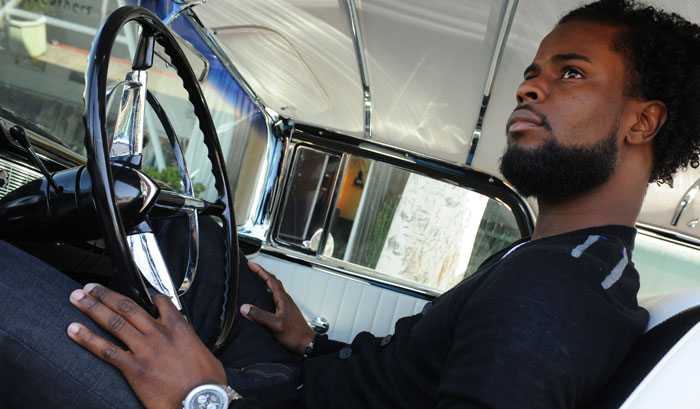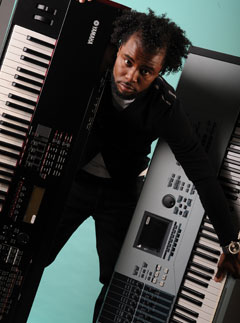


As musical director and keyboardist for Jay-Z, Omar Edwards is every bit the seasoned professional. But he's far from jaded: "Last night I had a show with Jay-Z and Mary J. Blige at the Hollywood Bowl," he says. "It was my first time there. It was amazing to be on that stage, and look up that far, and just see people!"
Edwards isn't merely lucky--there's plenty of talent and hard work behind his current position. Growing up in Wilmington, Delaware, young Omar took piano lessons and played in church. Later, he moved to Philadelphia and played with popular gospel group Tye Tribbett and G.A. Before connecting with songwriter-producer James Poyser, who has worked with Erykah Badu, Common, the Roots, Jill Scott, and Lauryn Hill, among others.
I think when Yamaha made this keyboard, they said, "We need to make an instrument that feels good, sounds good, and looks good."
"Once you get into that circle in Philly, you're constantly playing and working," he says. "You just walk into the studio one day, and you're in a session before you know it. It's a real tight musical family."

Omar's career really took off when he met drummer and producer ?uestlove from the Roots. "?uestlove is a Yamaha artist as well," he notes. "And working with him led to relationships with Common, Kanye West, and of course Jay-Z."
Edwards has performed with Jay-Z since 2002, when he participated in the rapper's MTV Unplugged sessions. Playing live with a star of Jay's caliber is an incomparable experience, he says.
"The feeling when he walks onstage is incredible. The way the audience responds, before we even touch anything! Then when you play his songs, it's hit after hit after hit. I think he's a lyrical genius, the stuff he talks about, the metaphors and the clever ways of bringing out issues, or even his life story. The energy is surreal--you just have to be there to experience that communication between the artist and the audience."
But Edwards has a job to do within this furnace of star power. "My main musical concern is making Jay feel comfortable," he explains. "I need to make sure the band can translate things sonically so they make sense to him. Because hip-hop guys are used to DJs, not a full band with live musicians. It's a completely different feel from R&B or jazz. It's about the textures, and making the record translate live."
A key concern, observes Omar, is keeping space in the music. "Less is more in hip-hop. It's not real melodious--he's not singing, he's rapping. It's rhythmic, and you have to make sure what we do doesn't clash or interfere with what Jay is saying. That's an art form in itself."
To craft the perfect sounds onstage, Edwards uses a Yamaha S90ES stage piano and a Motif XS8. "These keyboards are the greatest things ever," he says. "The S90ES is unbelievable. There's a piano sound in there that I love called the Dark Grand. Nothing comes close to that piano sound through a set of stereo monitors. I think when Yamaha made this keyboard, they said, 'We need to make an instrument that feels good, sounds good, and looks good.' I think it's beautiful: It's black, with cherry wood on the ends. Then the feel of the keyboard itself--it makes you play so gracefully. And you hear such true tones. The sounds are so authentic and rich. And it's easy to navigate, to tweak and edit the sounds. It's just a really user-friendly keyboard."
Not surprisingly, Edwards considers the S90ES his main keyboard. "I use it to control virtual synths too, because it feels so amazing," he says. "And I use the Motif for color, for things like synth patches. The sounds on that keyboard are unbelievable! They're so thick. There are eight faders, so you can have all these sounds up, and fade them in and out, or layer them, or split them. There's so much space--you have all 88 keys, and you can just map things everywhere."
These keyboards suit a wide variety of playing situations, he adds. "When I'm with different artists, I have to put on different hats--whether it's with Kanye, or Common, or when I'm playing in church. It's different again when I play with Jay. You need to be able to adapt, and know where to fit. And a lot of times, it's knowing when not to play at all."
On the current tour with Jay-Z, when it all comes together onstage, the feeling is unmistakable. "I use the audience as a gauge for how the show is going," says Omar. "I think it's kind of obvious when they're screaming! When we do the last song, and they stand there and scream, you've done your job. They don't move, they don't start leaving. And when Jay walks offstage and nods at me, or says, 'Good show,' I'm fulfilled--I'm cool."
(Photography Credit: Rob Shanahan)
























